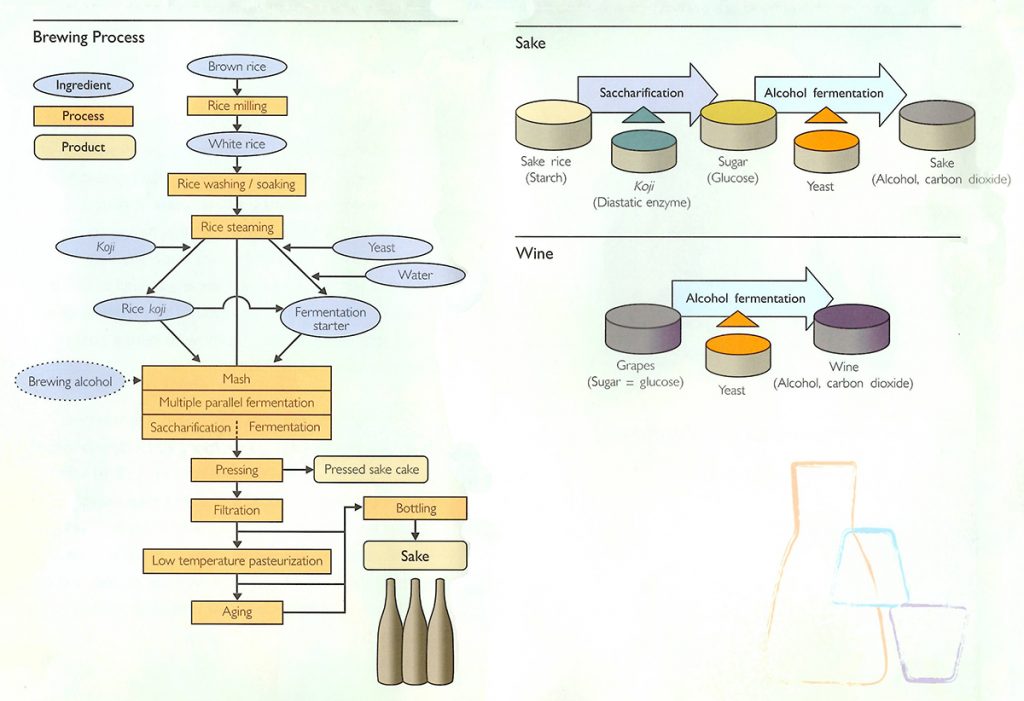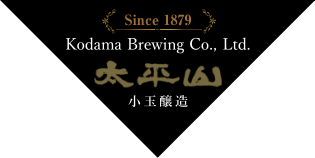About Sake
Brewing Process
Sake is in the same category of fermented liquor as wine and beer. Fermented beverages are alcoholic drinks made when yeast ferments alcohol from the agricultural crops used. That fermentation process differs for each type of drink, and a unique characteristic of sake is that it uses a sophisticated production method called multiple parallel fermentation.
Ingredients
• The primary ingredients in sake are rice, water, and rice koji.
Sake is a fermented beverage brewed using a microorganism called koji and yeast.
• It has an alcohol content of from about 13% to 16%.
• Japanese rice can generally be divided into two types:
table rice that is eaten, and sake rice that used exclusively for sake brewing.
• The rice varieties used in sake are the large-grain, soft varieties with a low protein content. They are more expensive because they are cultivated using more complicated methods.
• The quality of the water used in brewing sake is also important. Brewers take advantage of the various kinds of natural water available in Japan to make excellent sake.
Brewing Sake
• Sake is made by fermentation just like wine and beer, but it involves a more complex brewing process.
• Wine is naturally fermented by pressing grapes and adding yeast. Sake, however, is not fermented by adding yeast to rice, but through the use of koji, which converts the starch in the rice into sugar. The rice begins fermenting once the yeast is added to this sugar. Because the saccharification and fermentation processes occur in parallel in the same container, the process is called “multiple parallel fermentation.”
Sake Breweries in Japan
Sake breweries are located throughout Japan, from Hokkaido to Okinawa. There are about 2,000 brewers nationwide, and each makes several different varieties of sake, offering opportunities for people to enjoy unique tastes from each area and brewer.

Types of Sake
There are several different types of sake, and the following special designations are specified by the Japanese government.
Sake that falls outside the specially designated sake categories is typically called “futsu-shu“. This includes sake made with a rice polishing ratio over 70%, made with ingredients other than the ones approved for specially designated sake, and sake containing more than 10% brewer’s alcohol.
Daiginjo-shu (大吟醸酒)
Daiginjo-shu is a form of ginjo-shu made with even more highly polished rice from which at least 50% of the outer layer of the grain has been removed. It has an even more refined taste and stronger ginjo-ka than ginjo-shu.
Junmai Daiginjo-shu (純米大吟醸酒)
Junmai daiginjo-shu is regarded as the highest-grade sake. The best products in this class deliver a good blend of refined taste with acidity and umami.
Junmai Ginjo-shu (純米吟醸酒)
Because ginjo brewing techniques are used in making junmai ginjo-shu, the acidity and umami are toned down and there is a clear ginjo-ka.
Junmai-shu (純米酒)
Junmai-shu and tokubetsu junmai-shu are made only from rice, koji and water, highlighting the flavor of the rice and koji more than other varieties. There are no requirements regarding polishing ratio. Junmai-shu is typically high in acidity and umami, with relatively little sweetness.
Kimoto (生酛)
Kimoto starter culture
This sake is made with a traditional shubo (moto or yeast starter) that cultivates lactic acid bacilli before yeast propagation.
Namazake [Un-pasteurized sake] (生酒)
This sake is sent to market without any pasteurization in the production process. There are many types, such as junmai nama and ginjo nama.
Muroka [Unfiltered] (無濾過)
Sake is usually made by pressing the moromi after that, sake is filtered to stabilize the quality, but this sake skips that last step.
Genshu [Undiluted sake] (原酒)
Most sake on the market has had its alcohol content adjusted 15-16% through dilution with water, but since genshu is undiluted sake, it’s alcohol content is often quite high, at 18-20%.
Honjozo-shu (本醸造酒)
In honjozo-shu, the emphasis is on flavor and there is little ginjo-ka or aging‐induced aroma. It has a reasonable level of acidity and umami and rather than asserting the aroma and taste of the sake itself, it helps to bring out the taste of food.
Nigorizake [Cloudy sake] (にごり酒)
This is a white, cloudy sake made by straining the moromi through a coarse cloth only. Nigorizake that is shipped without pasteurization is called kassei seishu (active sake), and still contains living yeast and enzymes.
and more…
Reference:

Japan Sake and Shochu Makers Association
http://www.japansake.or.jp/sake/english/
